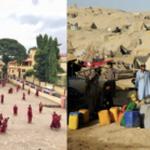Jaisalmer: a land of dwindling resources and flourishing resilience
"Better a cruel truth than a comfortable delusion." - Edward Abbey
Chandigarh, August 2023
I sat on the sofa, newly renovated by my mother as she brough me piping hot chai. Outside, the rain plays a steady rhythm on the windowpane. The tempest beat upon the world, a relentless symphony of nature’s asperity. Immersed in this elemental embrace, my thoughts drifted - a vague idea of my upcoming trip to Jaisalmer, a district in the western Rajasthan region of India, emerged with its contours yet undefined. My countenance must have mirrored my mind, for my perceptive mother gently inquired about the source of my distraction. With vigor, I unraveled my plans, each thread intricately woven into my ongoing research on Jaisalmer's natural resources. Then, I unfolded my laptop, revealing a meticulously detailed map of the district, pointing out the sites that I hoped to see. My mother - my captive audience - listened patiently and absorbed every syllable I spoke.
In a generous turn, she regaled me with tales of her years spent in Rajasthan. Especially Jaisalmer, a familiar chapter in her narrative. It wasn't long before I realized the depth of her knowledge of Rajasthan's biodiversity as she effortlessly recounted the names of its native wildlife. I was graciously allowed to access a rich reservoir of wisdom that she held within her. The invaluable insights she shared with me helped me define some contours of my impending research.
At 5:30 that evening, I was on the phone with Radheshyam Bishnoi, a farmer and conservationist from the remote Pokhran tehsil of Jaisalmer district. After informing him of my visit, I asked if he would be kind enough to share his lived experience with me. "How much time do you have?" was his first question, and without a moment's hesitation, I replied, "I am here for two months." Little did I know that this simple exchange would set in motion an eye-opening journey through the sand and dunes. We continued to speak for another hour and a half as Radheshyam painted a vivid picture of the environmental disturbances impacting Jaisalmer's biodiversity. For a brief moment, I clung to the hope that perhaps not everything was amiss in this arid land. But after hearing him describe the irreparable damage inflicted upon the area, my optimism faded. At that pivotal moment, I made a swift decision. I reached for my laptop and rescheduled my itinerary to Jaisalmer, determined to meet this passionate man at the earliest opportunity. I was eager to learn from the guardian of this fragile ecosystem.
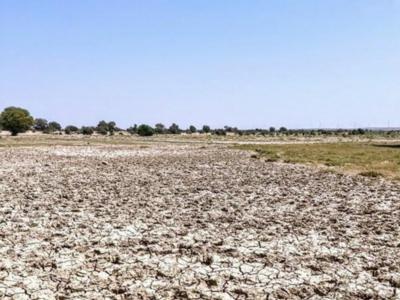
Oran
As the sun began to rise on the 15th of August, casting a golden glow over the ancient city of Jaisalmer, I saw young boys and girls waving the tricolour flag high above their heads with unbridled excitement. This was a picture of pure joy and a reminder of the unwavering spirit that led India to independence 73 years ago. On that same day, Radheshyam Bishnoi and I sat with cups of chai and watched the wind ripple through a fruit laden Khejri tree (Prosopis cineraria, a species of tree of cultural significance) in his village Dholiya. Without knowing where we were headed, I followed him around. "This is Bhadariya Oran", Radheshyam explains. It appeared as if it was an endless vista of native trees and cattle meandering freely at first glance.
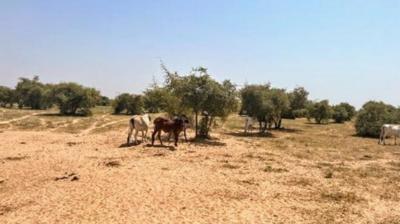
"What is an Oran?" I asked him. With the harsh sun beating down on us, we sought refuge beneath the shade of another Khejri tree blooming in this enchanting landscape. Radheshyam elucidated further, "An Oran is more than just a forest; it's a sanctuary belonging to the local community where no one can hack a tree." An Oran is a sacred grove of native trees protected by the local community. Each Oran has a deity worshipped by villagers. Slowly and gradually, I realised the significance of Oran, a place where nature and community have coexisted for thousands of years. Each branch and leaf of those revered trees tell stories of generations past.

Radheshyam Bishnoi asked me to accompany him to another Oran which according to him is a disturbed one. When I asked about disturbed in what sense, he said you will see for yourself. Around forty-five minutes from Bhadariya Oran, we reached Degray Oran. Radheshyam’s words resonated with undeniable truth; this Oran was different. As we walked through Degray Oran, the landscape was marred by a web of high- tension power lines and grids that crisscrossed the land. "This intrusion has compromised the delicate ecology and livelihoods of those who depend on these Orans," Radheshyam says.
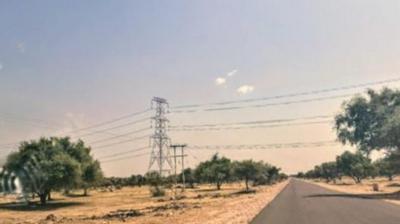
Not far from Degray Oran, we met Sumer Singh Bhati, a humble farmer from Sanwata Village who is leading the charge against the insidious changes happening with Orans. He expressed his concerns with poignant sincerity. "I am not against development," he began, "but my question is, what kind of development and development for whom? Our Orans with their centuries-old trees and grasses are handed over to renewable energy companies". These Orans are unrecorded, Sumer Singh added, "leaving them vulnerable to the government’s whims and fancies. Orans are more than just patches of land for pastoralist communities, they are an integral part of their culture. Orans provide fodder for their herds, grazing fields for their livestock and food for their tables".
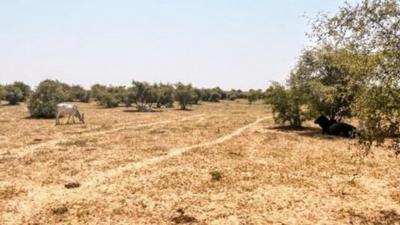
The heart of the problem in these Orans and much of Jaisalmer is the establishment of solar farms and the erection of colossal wind turbines over the past decade in pursuit of harvesting carbon credits. As Sumer Singh and Radheshyam Bishnoi gazed upon these technological giants, I couldn’t help but wonder: would the pursuit of carbon credits, driven by the juggernaut of big renewable companies, come at the expense of their ancestral lands and way of life? It is a story of hope and concern played out in the scorching heat of the desert.
Listening to Sumer Singh and Radheshyam Bishnoi took me to the crux of the problem. The reason the government hands over Orans which are grasslands to renewable energy companies lies in the colonial era nomenclature that puts all non-revenue land as 'wasteland'. In 1985, the National Wasteland Development Board was formed to bring 'wastelands' in the country into productive use through a massive afforestation programme and for 'improving land productivity'. The government started issuing the 'Wasteland Atlas of India' every few years. It defines 'wasteland' as "degraded land which can be brought under vegetative cover, and which is currently under-utilized and land which is deteriorating for lack of appropriate water and soil management or natural causes". With this definition, 68 per cent of Jaisalmer district was a 'wasteland'. "They [renewable energy companies] come, take our land, cut Khejri trees, and slowly everything is destroyed in front of our eyes", Sumer Singh says. The story doesn't end there as Sumer Singh and Radheshyam narrate to me how gigantic windmills are a hurdle for migrating birds. They kill the Great Indian Bustard, known locally as Godawan in Rajasthan. Birds often die trapped in these high-tension wires.
The Great Indian Bustard is a critically endangered species that is facing the heat of development. It is also listed in Schedule I of the Wildlife (Protection) Act 1972. "There is a loss of native grass called Sewan which has resulted in the loss of their population", says Radheshyam Bishnoi. There are several reasons for this, including irregular rainfall and the enclosure of Orans for solar and wind farms. The companies cut grassland to clear land for gigantic panels and fans. "With the loss of habitat in the name of development, we have to answer the very people for whom the development is intended." It is also a grave violation of the Supreme Court order which categorically ruled on April 19, 2021, that high-tension wires should be underground to protect the Bustard's habitat. But nothing has been done since then.

I gaze at the windmill blades. My silence is punctuated by their mournful sounds - the haunting melody of Godawan's deaths. I couldn’t help but ponder if this is the only way towards a sustainable future? Later that evening, Radheshyam invited me and four other people to attend a plantation ceremony. A short walk from Degray Mata Mandir, a Hindu temple dedicated to the Goddess Degray, we gathered, holding a sapling in our hands. After the ceremony, we retreated to a corner to escape the heat of the Thar desert where Radheshyam brewed a cup of aromatic chai. As we sat down, villagers' stories flowed, woven with laughter and shared experiences. I could see their resilience, a fire of determination in their demeanor to protect their sacred groves at all costs. To us outsiders, the desert may simply be dunes, a barren land or brousse tigrée that gives it the appearance of a tiger’s stripes seen from above. But, for these desert dwellers, many of whom are shepherds, every dune holds a story.
I saw a bond forged in the shared memories that ran deep within them all. They understood the arduous path ahead, but the Thar desert had bestowed them with unshakeable faith and commitment that no one can axe. They are the barefoot geographers and cartographers, traversing the arid landscape, attuned to its every contour and nuance. They bear witness to the profound changes brought by man, etched into their memories. Each of them has a story to share, but the question is whether we are there to listen.
Khadeens
On Monday, September 4, I got a call from Manohar Singh, a seasoned farmer from Jajiya village in Jaisalmer. He asked me to meet him at Hanuman Chowk [marketplace]. I did not anticipate that this humble man would become not only my mentor and guide, but also a dear friend, accompanying me on my journey through the many twists and turns.
Anticipating the scorching heat, we decided to commence our journey before the sun reached its zenith. The temperature that day soared to an unprecedented 42 degrees Celsius, a record-breaking high for September since 1947. As Manohar Singh spoke, I observed subtle shifts in his expressions, reflecting the harsh reality of a year devoid of rainfall. The earth beneath us appeared desiccated, semi-parched, patiently yearning for the life-giving touch of rain.
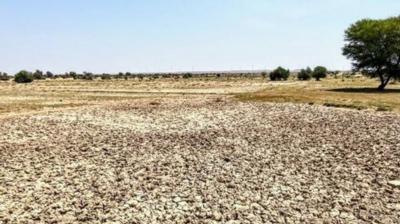
"The land has more patience than us. As humans, we often struggle with impatience. What we don’t see is the profound connection between the land and the sky and how the two hold each other. Both are intimately and inextricably linked", says Manohar Singh. It took me a while to understand what he meant by it. The region, on average, receives a mere 80-100 millimeters of rainfall, a stark contrast to the bountiful 3000 millimeters experienced by Kerala, the southwestern coastal state of India.Yet, desert dwellers faced no water crisis, thanks to the ancient water harvesting technique known as Khadeens.
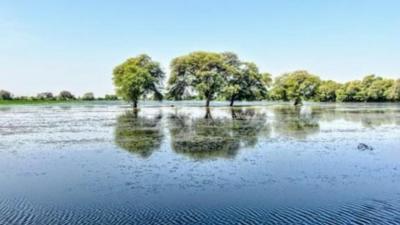

Khadeen is an area or farm that connects land and people. It is an ancient water harvesting technique that creates an oasis and an agricultural field. Manohar Singh took me to one such Khadeen and I was awestruck. I had never seen an oasis with so much water and witnessed so many pelicans at once. According to Manohar Singh, the Khadeens, which date back to 800 years ago, were the brainchild of Paliwal Brahmins. Because there are no written records of Khadeens, their stories are passed down orally through generations to the Manganiyar community, the bards of the desert.
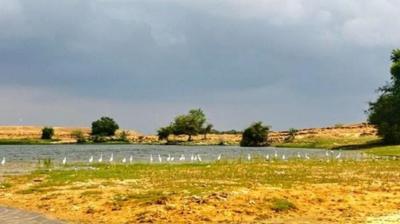
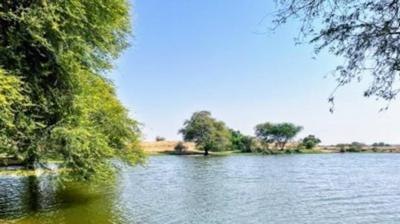
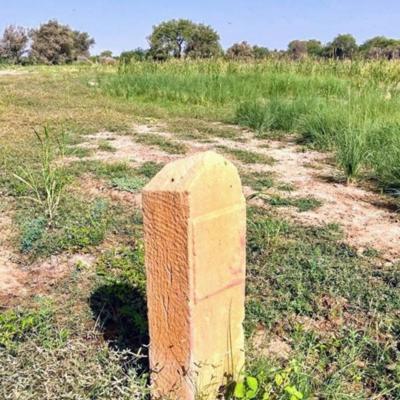
But Manohar Singh told me how we are losing Khadeens and in the next ten years it will be very difficult to restore them. Jaisalmer is known for its yellow stone which is mined and exported worldwide. Unfortunately, rampant illegal mining of yellow stones has led to the destruction of Khadeens' catchment area. "How will the water reach the Khadeens if you destroy the aagor - the water catchment areas?" asks Manohar Singh. I accompanied him to a mining site in Jajiya. Here, the earth bore the scars of countless rocks illicitly extracted, sacrificing the once-thriving Khadeen. We stood there, witnessing the insatiable greed that jeopardized these vital ecosystems. In a landscape where justice seemed elusive, countless Khadeens suffered similar fates, their stories echoing unheard.
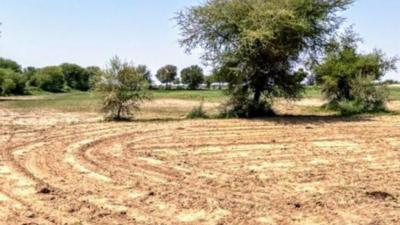
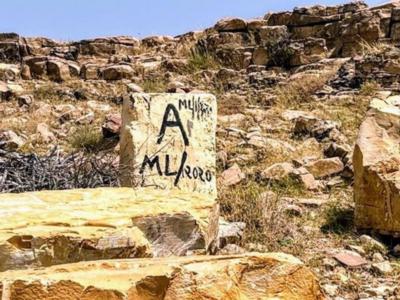
After travelling with Manohar Singh for weeks to different villages and interacting with people, I decided to visit the most visited place in Jaisalmer, Sam. This is a tourist magnet known for its paragliding, and desert safari. In the evening, you can watch folk music performed by the Manganiyar community and Kalbelia dance by the Nath community. That evening I watched the performance, but my mind was elsewhere. Jaisalmer is one of the districts where groundwater conditions are critical due to severe exploitation. The accessibility of water in terms of drinking and sanitation for rural people depends on the traditional source of water like Beris, Khadeen or Jasiri Lake which are commons. My conversations with individuals such as Manohar Singh, women from the Meghwal and Bhil communities, and Chima Ram, a shepherd from the Bhil community, have revealed that none of their households have access to a water pipeline. Their only source of water is from the tankers who get water from the commons and deliver it to their doorsteps. A tanker is just a big drum made from sheets of steel plate. The average capacity is 5000 liters and can be carried by trucks, lorries and other large vehicles. The tankers collect, transport, and sell water. Many of the tankers are privately owned by the Rajput community, who are descendants or members of the Kshatriya (warrior ruling) class but vary in status from princely lineages to simple cultivators.
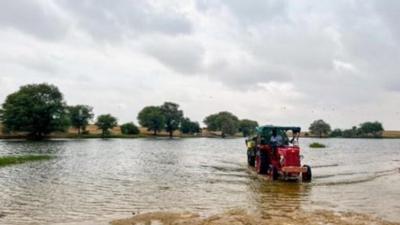
I realised the pitiable condition which is worsened by less rainfall and aggravated by the booming water tanker industry. So, I followed four tankers roughly 20 km from Sam to see where they were headed. I ended up in a resort made of yellow stones. Unlike the traditional architecture of other resorts, to my surprise this resort had individual tents covered with modern amenities and private swimming pools. When the manager told me that the tiles that they used on the floor came from Dubai, I was awestruck. Is this the same district where desert dwellers and marginalised communities struggle and spend more than half of their monthly wages buying water from tankers? While this resort offered water in abundance for the tourists and the rich?
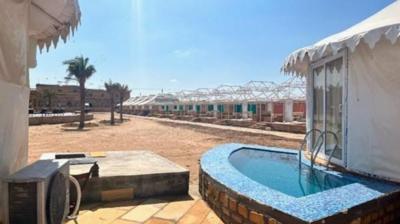
The manager stated that there are twenty-five suites and semi-luxury rooms in the resort. With pride, he revealed that the owner is considering purchasing the other property as well, which will be more luxurious and can accommodate large groups of people during the high tourist season. Destination weddings have become a business for many resorts as people fly to Jaisalmer to get married in five-star resorts and hotels. Such inequality in our society needs a different prism to understand and articulate it. This dichotomy poses the question if the dwindling of natural resources is the only justification of its unequal access, or the problem lies in its allocation? David Attenborough warned us: "We have a finite environment — the planet. Anyone who thinks that you can have infinite growth in a finite environment is either a madman or an economist."
